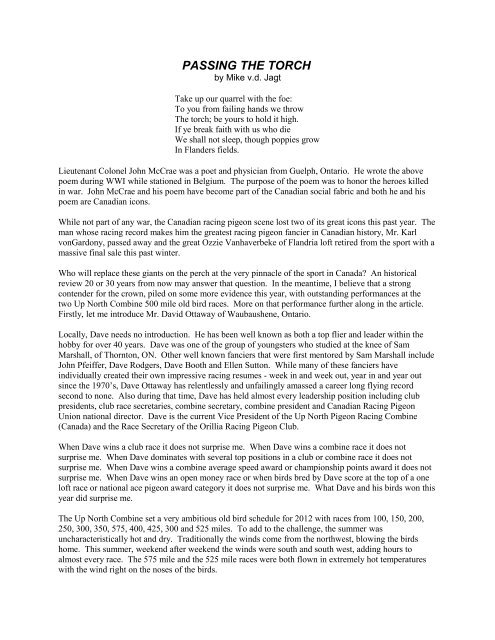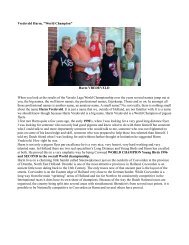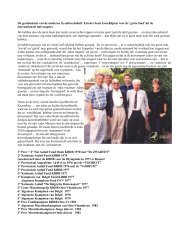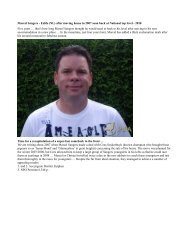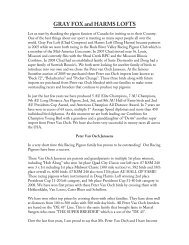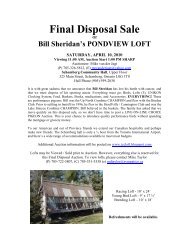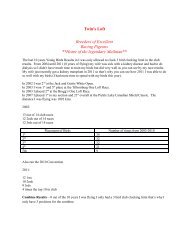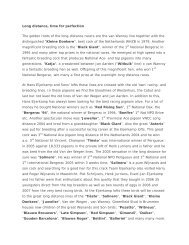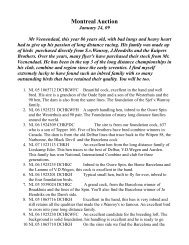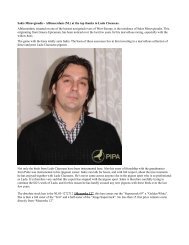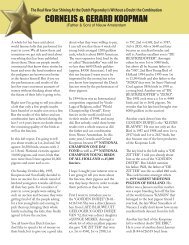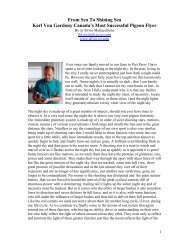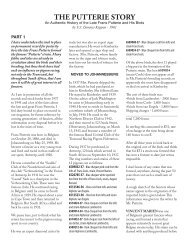PASSING THE TORCH - Choice Pigeon Auctions
PASSING THE TORCH - Choice Pigeon Auctions
PASSING THE TORCH - Choice Pigeon Auctions
Create successful ePaper yourself
Turn your PDF publications into a flip-book with our unique Google optimized e-Paper software.
<strong>PASSING</strong> <strong>THE</strong> <strong>TORCH</strong><br />
by Mike v.d. Jagt<br />
Take up our quarrel with the foe:<br />
To you from failing hands we throw<br />
The torch; be yours to hold it high.<br />
If ye break faith with us who die<br />
We shall not sleep, though poppies grow<br />
In Flanders fields.<br />
Lieutenant Colonel John McCrae was a poet and physician from Guelph, Ontario. He wrote the above<br />
poem during WWI while stationed in Belgium. The purpose of the poem was to honor the heroes killed<br />
in war. John McCrae and his poem have become part of the Canadian social fabric and both he and his<br />
poem are Canadian icons.<br />
While not part of any war, the Canadian racing pigeon scene lost two of its great icons this past year. The<br />
man whose racing record makes him the greatest racing pigeon fancier in Canadian history, Mr. Karl<br />
vonGardony, passed away and the great Ozzie Vanhaverbeke of Flandria loft retired from the sport with a<br />
massive final sale this past winter.<br />
Who will replace these giants on the perch at the very pinnacle of the sport in Canada? An historical<br />
review 20 or 30 years from now may answer that question. In the meantime, I believe that a strong<br />
contender for the crown, piled on some more evidence this year, with outstanding performances at the<br />
two Up North Combine 500 mile old bird races. More on that performance further along in the article.<br />
Firstly, let me introduce Mr. David Ottaway of Waubaushene, Ontario.<br />
Locally, Dave needs no introduction. He has been well known as both a top flier and leader within the<br />
hobby for over 40 years. Dave was one of the group of youngsters who studied at the knee of Sam<br />
Marshall, of Thornton, ON. Other well known fanciers that were first mentored by Sam Marshall include<br />
John Pfeiffer, Dave Rodgers, Dave Booth and Ellen Sutton. While many of these fanciers have<br />
individually created their own impressive racing resumes - week in and week out, year in and year out<br />
since the 1970’s, Dave Ottaway has relentlessly and unfailingly amassed a career long flying record<br />
second to none. Also during that time, Dave has held almost every leadership position including club<br />
presidents, club race secretaries, combine secretary, combine president and Canadian Racing <strong>Pigeon</strong><br />
Union national director. Dave is the current Vice President of the Up North <strong>Pigeon</strong> Racing Combine<br />
(Canada) and the Race Secretary of the Orillia Racing <strong>Pigeon</strong> Club.<br />
When Dave wins a club race it does not surprise me. When Dave wins a combine race it does not<br />
surprise me. When Dave dominates with several top positions in a club or combine race it does not<br />
surprise me. When Dave wins a combine average speed award or championship points award it does not<br />
surprise me. When Dave wins an open money race or when birds bred by Dave score at the top of a one<br />
loft race or national ace pigeon award category it does not surprise me. What Dave and his birds won this<br />
year did surprise me.<br />
The Up North Combine set a very ambitious old bird schedule for 2012 with races from 100, 150, 200,<br />
250, 300, 350, 575, 400, 425, 300 and 525 miles. To add to the challenge, the summer was<br />
uncharacteristically hot and dry. Traditionally the winds come from the northwest, blowing the birds<br />
home. This summer, weekend after weekend the winds were south and south west, adding hours to<br />
almost every race. The 575 mile and the 525 mile races were both flown in extremely hot temperatures<br />
with the wind right on the noses of the birds.
The 575 came first on 14 JUN 2012 from Nakina ON. The race the week previous from 350 miles had<br />
proven the toughest of the year to date with many lofts filing no reports or were hours behind. Racing<br />
conditions had appeared favorable; it was just unseasonably hot with challenging headwinds. The<br />
winning velocity was 1089 m/m and the leading birds were quite scattered. Of the 641 birds entered in<br />
the race, it took over 7.5 hours after the first bird was clocked, over two days, to close out the prizes. The<br />
weather pattern had remained stable over the entire race course in the week that followed, and conditions<br />
would be identical for the 575 mile. Of the many top competitors that I spoke to, none predicted day<br />
birds.<br />
It turned out to be a classic long distance marathon with only two birds home on the day. After 13.5<br />
grueling hours in 90 degree plus temperatures and 5 to 10 mph headwinds all the way, Dave clocked the<br />
combine winner at 7:30:03 p.m. with a speed of 988m/m. This was not a smash; it was a classic long<br />
distance race. I claim this because the lack of day birds was due to the fact that the distance exceeded 500<br />
miles and the heat and head winds made the conditions fair for everyone and decent enough for a really<br />
good pigeon in really good condition and with super motivation, to make it on the day. If the bird was<br />
even slightly lacking and any of those areas, it would go down. In other words, the day presented ideal<br />
conditions for the cream to rise to the top.<br />
As I said, when Dave wins a combine race it does not surprise me, but I was impressed. Winning a<br />
classic 500 by clocking only one of two birds on the day is a rare feat and one few of us will ever achieve.<br />
The really unexpected happened 4 weeks later at the 525 mile Longlac race. Conditions for this race were<br />
identical. Again no one expected day birds. Again, Dave Ottaway beat the odds and clocked two of only<br />
three day birds to once again win 1 st UNC. This was a little more than impressive, but still, Dave is a top<br />
flier and if anyone would get a day bird, I would count him on the list. What truly surprised me was that<br />
one of Dave’s two day birds, was the same bird that had won the 575 mile classic four weeks previously.<br />
We had just witnessed two classic performances at the 500 within a month, with the same bird - that<br />
surprised me.<br />
Dave was happy to share the story of this bird with me and I in turn would like to pass it along. The bird<br />
is band number 09-CU-ORI-0077. It is a medium sized blue bar cock with a yellow eye. The pigeon has<br />
all the physical traits one would expect of a champion with an excellent throat, strong muscles, buoyant<br />
skeleton, narrow well ventilated end flights, one pin tail etc.<br />
Dave uses several racing systems including double widowhood, classical widowhood and nest. He will<br />
sometimes switch pigeons between systems. This particular cock bird flew to a nest all season. He was<br />
510 th combine in the first race of the year, 437 th combine from the 4 th race of the year, 1 st combine 500<br />
miles from the 7 th race of the year and 3 rd combine 500 miles at the 11 th race of the year.<br />
It would appear that Dave raced the bird once on each nest cycle, approximately once every four weeks.<br />
That might explain the reserves the bird had that allowed him to stay on the wing in blistering heat for<br />
13.5 hours in the first 500 and 14.5 hours in the second 500.<br />
For the first race, 0077 was mated to the same hen he had been with all year and was sitting 15-16 day<br />
eggs. His mate failed to return from the same race, so he was given a new mate for the next classic 500.<br />
He went to that race on 1-2 day old youngsters. That would mean that this remarkable bird not only flew<br />
and won a classic 500 mile race, but then accepted a new hen, went thru the driving cycle, hatched out the<br />
next round of babies and then flew his second classic 500 race within a month – this time completing the<br />
race in 14 hours and 26 minutes on the wing in high heat and head winds. Wow!<br />
The bird comes with a blue chip pedigree. To name just a few great performances by close relatives, his<br />
full brother was 12 th Upper Canada National in 2010 against 2534 birds and another half brother won the
Up North Combine Yearling Open this year. From the 2010 breeding year, 2 brothers and two sisters<br />
have become race winners and from the 2011 breeding season no less than one brother and FIVE sisters<br />
have won races.<br />
On his sire’s side he comes down from Ganus bloodlines of the Aviator/Black Widow and Hollywood<br />
(Hofkens). The dam represents the best of Dave’s foundation bloodlines, the Smeulders Janssens and<br />
more particularly his Birthday cock, a direct son of Showgun. This is the 531 line of Smeulders and has<br />
bred more first place winners for Dave then he can count.<br />
CU-09-ORI-0077<br />
EYE OF SIRE<br />
As can be seen this cock has a very good fifth circle showing that the<br />
blood supply is good and oxygen supplied to whole body for health<br />
and energy, especially when racing.<br />
Next is the raised and clumped iris which shows those mountains and<br />
valleys that many can not see or say are not there. The iris leads to a<br />
deep step down to the very wide yellow circle of correlation or c/c as<br />
it's called where you'll see a multitude of lines within this circle telling<br />
you that this bird has the ability to fly the long distance races. Also in<br />
this c/c you will see another deep step from 11 to 4 which adds value<br />
to this eye. At this point you will see a shadow of the scouting circle<br />
showing through the composite c/c which is a yellow overlay on black.<br />
The outer edge of c/c has serrations which are also a clue to the worth<br />
of this bird.<br />
Next in line is the circle of adaptation or c/a. this is found on the inner<br />
edge of the c/c just as it meets the *** hole, we call pupil. The c/a here<br />
can be seen as beaded and will show much better in direct sunlight.<br />
Even though this detailed write-up comes -- after the fact -- it is given here as a<br />
learning tool and aid for those wishing to study and further their knowledge of<br />
--- eyesign evaluation --.!!!!<br />
Here we can also see where the great eye qualities came from as we look into eye of the sire:<br />
1. <strong>THE</strong> 5TH CIRCLE HEAVY AND DARK.<br />
2. IRIS FULL OF LIFE AND RAISED SHOWING DEPTH.<br />
3. EXTREMELY WIDE SERRATED C/C A DEEP STEP DOWN FROM IRIS.<br />
It also shows distance lines galore and of a color that most don't have in abundance anymore. the<br />
once famous *** green tint *** to the c/c which Stan Bishop, always spoke about in his books about<br />
eyesign in the UK.<br />
At the forefront you'll see a fairly heavy black scouting sign which denotes racing quality. Though<br />
hard to see by most, there is a very heavy beaded c/a here to add to the already top quality of this sire.<br />
A very special breeder eye that most should strive to get for their stock loft.<br />
EYE OF DAM<br />
Shows lighter color of 5th circle than sire or son, but has the same good iris quality being full and<br />
clumped with depth leading down with a step to the extremely wide serrated greenish c/c.<br />
The c/c has both speed and distance lines in it, full around with a 3/d funnel effect leading down to<br />
the c/a, where we see the beaded c/a in good width.<br />
This combined qualities of these two parents ::: produced a great win.<br />
All photos by Dave Ottaway<br />
All eye evaluations by Myron Kulik – Eyesign 101
The story is only half told if I do not mention the other bird that Dave clocked on the day in the final 500<br />
of the season, giving Dave the 1 st and 3 rd combine positions with only three birds home on the day of toss.<br />
This great bird is 09-CU-24815. He comes from a fantastic family of Janssen/vanLoon pigeons that have<br />
really complemented Dave’s Smeulders family. The Nakina race in 2011 was another very tough race<br />
with only eight day birds. A full sister to 24815 was one of them. In total, two sisters and two brothers<br />
have earned CU champion certificates, including a long distance National Ace award. This is truly a<br />
family of pigeons that can deliver the goods at all distances and particularly on the long end.<br />
Some might be surprised to learn that 24815 is also a cock bird. This hobby is steeped in myths that the<br />
facts do not support. One of these myths is that only hens can win the real tough classic 500 miles races –<br />
wrong! I judged 24815 to be a perfect specimen. He had a rich pearl eye, perfect medium sized balanced<br />
bird with a perfect throat. The forearm was short, the feather abundant and silky, perfect wing and one<br />
pin tail.<br />
CU-09-24815<br />
EYE OF SIRE<br />
CU-09-24815 has a good close cere covering and protecting the eye,<br />
while racing against the elements. The 5th circle is dark with good<br />
blood supply.<br />
The iris is of excellent quality with raised and clumped veins showing<br />
great depth adding value to the overall grading. this steps down a<br />
notch to very wide nicely serrated c/c which shows many diagonal<br />
marks across the c/c for speed and also concentric lines showing<br />
distance ability. Also showing well is the black scouting half moon<br />
where a deep step shows from 1 to 6 o'clock. The c/a is beaded, but<br />
hard to see unless blown up to 200%. When studying the eyes an<br />
loupe is always recommended. A super racer, but will also be a great<br />
breeder.<br />
As you have already been looking at a few other eyes here, you should be able to recognize some of<br />
the better features for racing and breeding in this eye.<br />
1. Is the good 5th ring.<br />
2. Is the super iris.<br />
3. Is the super great c/c, and here we will go into more detail, because this c/c is very special, as is<br />
that of his mate, the dam of 24815. Starting with the black scouting half moon and looking to the rear<br />
of the eye, you will notice that the widening serrated c/c is gradually getting wider as it goes to the<br />
far rear of the eye. This is a dead give a way of a super bird.!!! in all aspects- racing and or breeding.!!!<br />
4. The c/a is here is also beaded adding quality to the overall grading of the bird. The c/c @ # 3 has<br />
both speed and distance lines as well.one bird to die for in your loft.!!!<br />
EYE OF DAM<br />
Is a super bird .!!!!!!! to start with :::<br />
1. Her fifth circle or blood ring is the best possible.!!!<br />
2. The iris can't be beat.!!!<br />
3. Believe it or not her narrow c/c still has a step down to it. She also has the racing signs in there too.<br />
The c/c also does get wider going to the rear of eye, just like her mate, sire of 24815. 4. The extra<br />
special features that she has is a pinpoint pupil with *** super beads *** on the outer edge next to<br />
c/c's inner edge.<br />
She should stay mated as she is now and will produce far more winners and breeders of winners.
I doubt the 2012 performances of Dave Ottaway and his two champion birds would be enough to inspire<br />
Lieutenant Colonel John McCrae to create an iconic poem for the ages, but I am sure that had either of<br />
our old Canadian champions, Karl or Ozzie ended a season in similar style, they would have been very<br />
pleased with themselves.<br />
Congratulations Dave for putting the cherry on top of another great racing season.<br />
Mike van der Jagt<br />
Orillia Racing <strong>Pigeon</strong> Club<br />
mrvanderjagt@yahoo.com


